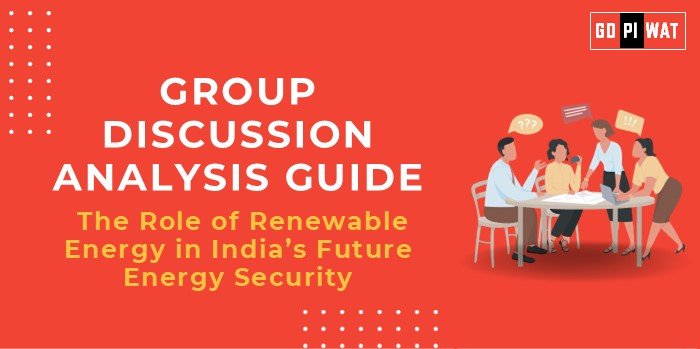🌟 Group Discussion Analysis Guide
⚡ Topic: The Role of Renewable Energy in India’s Future Energy Security
🌐 Introduction
- Opening Context: “India’s energy landscape is undergoing a profound transformation. With renewable energy accounting for nearly half of its total power capacity, the nation is positioning itself as a global leader in sustainable energy.”
- Topic Background: Renewable energy in India has seen rapid growth due to favorable policies, international collaborations, and ambitious targets. With a focus on achieving 500 GW capacity by 2030, India is poised to meet its surging energy demand sustainably.
📊 Quick Facts & Key Statistics
- 🌞 Installed Renewable Energy Capacity: 203.18 GW as of October 2024, a 13.5% growth from the previous year.
- 🎯 Target for 2030: 500 GW, including 280 GW from solar and 140 GW from wind.
- 🌍 Global Ranking: 3rd largest producer, with renewables constituting 46.3% of total installed capacity.
- 📈 Energy Demand Growth: Expected to double by 2031, with 70-80% of additional demand sourced from renewables.
🔑 Stakeholders and Their Roles
- 🏛️ Government Agencies: MNRE drives policy, SECI oversees auctions, and state-level agencies implement localized projects.
- 🏭 Private Companies: Major contributors to solar farms, wind parks, and green hydrogen production.
- 👥 Citizens: Adopters of rooftop solar and decentralized energy systems.
- 🌐 International Organizations: Collaborate on funding and technology transfer (e.g., IRENA, World Bank).
🏆 Achievements and Challenges
🎯 Achievements
- 📈 Capacity Expansion: 203.18 GW renewable capacity as of October 2024, marking steady growth.
- 🌍 Global Leadership: Third largest renewable energy producer globally.
- ☀️ Solar Power Progress: Rajasthan and Gujarat lead solar energy initiatives.
- 📜 Policy Initiatives: International Solar Alliance (ISA) and Production-Linked Incentive (PLI) schemes support the ecosystem.
⚠️ Challenges
- 🔌 Grid Modernization: Need for upgraded infrastructure to manage intermittent energy sources.
- 🌾 Land Availability: Land conflicts impact large-scale renewable installations.
- 🔋 Energy Storage Costs: Battery solutions remain expensive.
💡 Effective Discussion Approaches
- 🎯 Opening Approaches:
- Highlight the 13.5% year-on-year growth in renewable capacity.
- Present India’s target of 500 GW by 2030 as a foundation for discussion.
- Raise questions about the role of storage and grid systems.
- 🛠️ Counter-Argument Handling:
- Discuss solutions like hybrid power systems and international collaborations for cost-efficient energy storage.
- Address land conflicts by advocating community-based energy projects.
📊 Strategic Analysis of Strengths & Weaknesses
- 💪 Strengths: High solar potential (280 GW target), strong government and international support.
- ⚠️ Weaknesses: Limited storage capacity, land acquisition, and policy disparities.
- 🌟 Opportunities: Emerging green hydrogen markets, innovations in offshore wind energy.
- ⚡ Threats: Fossil fuel subsidies, regulatory hurdles, and delayed approvals.
🛠️ Structured Arguments for Discussion
- 💬 Supporting Stance: “Renewable energy has become the backbone of India’s energy security, enabling economic and environmental sustainability.”
- ❌ Opposing Stance: “Challenges like storage inefficiency and land acquisition slow down renewable energy’s full potential.”
- ⚖️ Balanced Perspective: “India’s renewable journey is promising but requires strategic interventions in storage and policy harmonization.”
📚 Connecting with B-School Applications
- 📊 Real-World Applications: Case studies on financing renewable projects, operations management in hybrid power systems.
- 📄 Sample Interview Questions:
- “What role can startups play in accelerating India’s renewable energy targets?”
- “How does renewable energy impact India’s global standing in climate negotiations?”
- 💡 Insights for Students: Explore renewable energy finance for internships, research the economic impacts of energy transitions.


